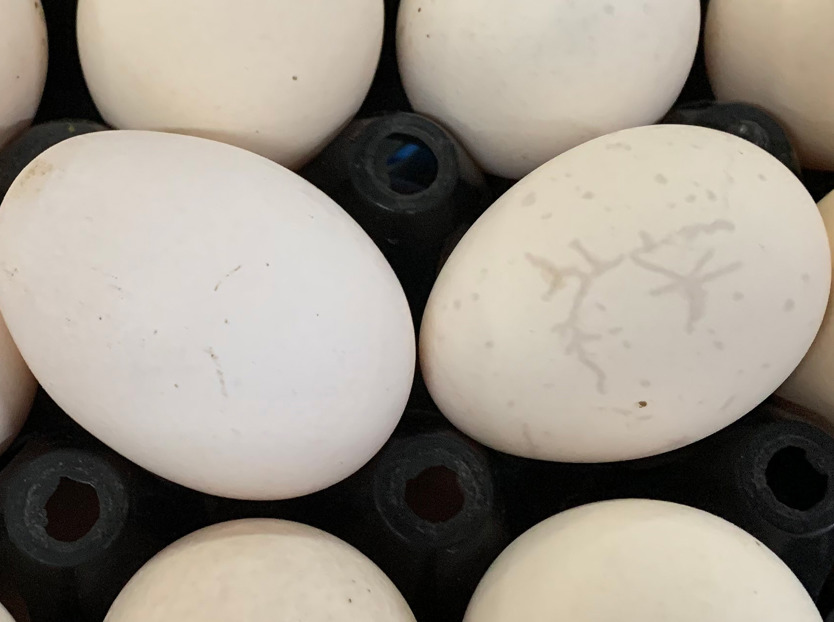In addition to temperature, CO2/O2 levels and humidity, egg turning is a critical factor that greatly influences incubation success. It is well-known that neglecting to turn eggs during incubation reduces hatchability and lowers chick quality. Turning is also significant during storage, as it can improve the viability of eggs stored for longer periods. This article delves into the biology behind egg turning, its importance during both incubation and storage, and highlights signs of turning inadequacy.
Unveiling the biology
The development of a chick begins with a single cell formed by the union of two parental cells, the ovum (contained in the egg yolk) and sperm, through the process of fertilization. Over time, this cell rapidly divides, forming the complex structures that will later become a fully developed chick. For this development to proceed smoothly, the chick embryo needs a steady supply of essential nutrients and oxygen.
In nature, the mother hen turns her eggs multiple times a day, ensuring uniform nutrient distribution. Her instinctive behaviour also fine-tunes temperature, oxygen and humidity levels, allowing the embryo to develop optimally. Mimicking this natural process in commercial incubation is crucial for creating the conditions necessary for optimal embryo development.
Why egg turning is vital for embryo development
Turning during incubation is crucial for normal embryonic development. However, turning can also be beneficial during storage, particularly for eggs stored longer than seven days. The older the eggs get, the more their quality deteriorates, and consequently, the benefits of turning during storage become more apparent. Moreover, older flocks benefit more from turning during extended storage. The main reason for turning eggs during storage is to prevent the embryo membranes from adhering to the inner shell membrane when left in one position for too long. Additionally, egg turning prevents the embryo from floating against the air cell, which reduces the risk of dehydration. Therefore, installing an automatic turning system in egg storage rooms is a proven technique for improving embryonic viability and consequent hatch results.
Below is an overview of the multiple vital purposes of egg turning, each contributing to the overall viability and health of the developing embryo:
1. Uniform nutrient distribution
Egg turning ensures the uniform distribution of nutrients within the egg, guaranteeing proper nutrient intake as the developing embryo has access to all essential resources needed for growth. This process is particularly critical between days 0 and 7 of incubation, when the early extra-embryonic yolk sac membrane (‘area vasculosa’ and vitelline membrane) and sub-embryonic fluid are forming. If embryos are not turned, nutrient uptake is compromised, which has a major negative impact on embryo development.
2. Prevention of adhesion
Regularly turning the eggs prevents the embryo from adhering to the inner shell membrane, allowing it to move freely within the egg. This free movement is crucial for the proper development of vital structures such as the circulatory and musculoskeletal systems and ensures the embryo can bring itself into the correct position for hatching later in the process.
3. Enhanced respiratory function
Regular turning helps prevent the embryo from pressing against the shell membrane, which could impede the exchange of gases essential for respiration. Adequate oxygen supply is critical to serve the metabolic needs of the developing embryo.
4. Prevention of deformities
Properly turned eggs experience uniform development, reducing the likelihood of deformities such as twisted limbs, organ malformation or embryo malposition. Consistent egg rotation left and right ensures that all parts of the embryo receive equal exposure to the surrounding environment, promoting symmetrical growth.
What happens if eggs are not properly turned?
Proper egg turning during incubation involves several aspects such as turning angle, frequency and technique. Modern setters typically operate with a turning angle between 38 and 42 degrees. Angles which are less than 35 degrees are known to decrease hatch results. Eggs are typically turned with a frequency of 24 times per day until the 18th day of incubation. Research shows that stopping turning after day 10 decreases hatchability, while ceasing after 15 days has a lesser impact. Interestingly, Petersime's trials revealed that increasing the turning frequency 2-4 times during the first week of incubation improves hatchability by 0.3%, primarily due to reduced late embryonic mortality. Regarding the technique, it is crucial that the turning system operates smoothly to avoid damaging the delicate embryo. Sudden movements or excessive jostling can disrupt the developing structures inside the egg. Therefore, proper maintenance of the trolleys and turning system is mandatory to reap the benefits of turning.

Based on incubation audits in hatcheries worldwide, some of the most common issues related to inadequate egg turning are:
- Early death: Insufficient turning can cause embryo death between days 3 and 6 of incubation.
- Mid-term death: Although less common, improper turning can also cause embryo death between days 7 and 17 of incubation.
- Failure to pip: Inadequate turning results in decreased development and poor nutrient absorption, which can cause a fully developed embryo to fail to pip.
- Dead in shell: If an embryo pips but fails to hatch, this can be caused by inadequate turning during the first 12 days of incubation.
- Malposition: An increased malposition rate during the hatch is a key indicator of a sub-optimal turning frequency or angle.
These issues can arise for various reasons. If an embryo fails to pip or dies early, it doesn't necessarily mean turning was the problem. However, examining every aspect of the incubation process, including the turning system, frequency and angle, is relevant to ensuring high hatch results.
In summary
What nature does effortlessly through instinct, we must replicate through technology in our incubators. By understanding the biological necessity of egg turning and considering key factors such as the required turning frequency and angle during the setting cycle, hatcheries can maximize their incubation success.
Petersime is happy to help you in learning more about incubator technology and embryo development. The topic is covered in our advanced training programmes. Please don’t hesitate to contact us for more information.




